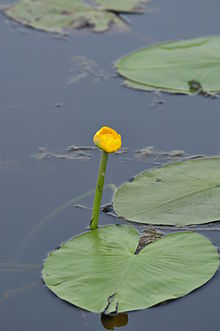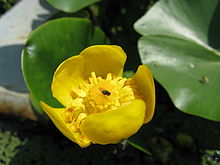- Nuphar
-
Nuphar 
Nuphar lutea, Lago di Fimon, Arcugnano, Italy Scientific classification Kingdom: Plantae (unranked): Angiosperms Order: Nymphaeales Family: Nymphaeaceae Genus: Nuphar
Sibth. & Sm.Species See text
Synonyms - Nymphozanthus Rich. (nom. rej.)
Nuphar is genus of aquatic plants in the family Nymphaeaceae, with a temperate to subarctic Northern Hemisphere distribution. Common names include water-lily (Eurasian species; shared with many other genera in the same family), pond-lily, and spatterdock (North American species).
A total of eight species and three hybrids are currently accepted in the genus.[1] A few botanists treat the genus as just a single variable species (for which the European name N. lutea has priority),[2][3] while 10–12 or more species are accepted by some other authorities.[4] Recent molecular work has shown that there are substantial differences between the European and American species.[4]
The genus is closely related to Nymphaea. Nuphar differs in having its petals being much smaller than its 4-6 bright yellow-coloured sepals, whereas in Nymphaea, the petals are much larger than the sepals. The fruit maturation also differs, with Nuphar fruit being held above water level to maturity, whereas Nymphaea fruit sink below the water level immediately after the flower closes. Both genera share leaves with a radial notch from the circumference to the petiole (leaf stem) in the centre.
Contents
Species
- Nuphar advena (Aiton) W.T.Aiton –Spatterdock
- Nuphar japonica DC.
- Nuphar lutea (L.) Sm. – Yellow Water-lily
- Nuphar microphylla (Pers.) Fernald
- Nuphar polysepala Engelm.
- Nuphar pumila (Timm) DC. – Least Water-lily
- Nuphar saggitifolia (Walter) Pursh
- Nuphar variegata Engelm. ex Durand – Variegated Pond-lily
Hybrids
- Nuphar × rubrodisca Morong (N. microphylla × N. variegata)
- Nuphar × saijoensis (Shimoda) Padgett (N. japonica × N. pumila)
- Nuphar × spenneriana Gaudin (N. lutea × N. pumila)
Ecology
Nuphar species occur in ponds, lakes, and slow-moving rivers, growing in water up to 5 metres deep; different species show adaptation to either nutrient-rich waters (e.g. N. lutea) or nutrient-poor waters (e.g. N. pumila).[5]
Alkaloids in the genus include nupharolutine, nuphamine and nupharidine.[6]
Etymology
The etymology of the word is: medieval Latin nuphar, from medieval Latin nenuphar, thence from Arabic nīnūfar, thence from Persian nīlūfar, thence from Sanskrit nīlōtpala = blue lotus flower.[7] For botanical gender, the name is treated as feminine.[1][4]
References
 "Field" of Nuphar on a small lake, Kenai National Wildlife Refuge, Alaska
"Field" of Nuphar on a small lake, Kenai National Wildlife Refuge, Alaska
- ^ a b USDA Germplasm Resources Information Network: Nuphar
- ^ Beal, E. O. (1956). "Taxonomic revision of the genus Nuphar Sm. of North America and Europe". Journal of the Elisha Mitchell Scientific Society 72: 317–346.
- ^ USDA Plants Profile Nuphar
- ^ a b c Wiersema, J. H.; Hellquist, C. B. (1997). "Nymphaeaceae". Flora of North America 3. http://www.efloras.org/florataxon.aspx?flora_id=1&taxon_id=122507.
- ^ Blamey, M. & Grey-Wilson, C. (1989). Flora of Britain and Northern Europe. ISBN 0-340-40170-2
- ^ Wrobel, J. T., Iwanow, A., Braekman-Danheux, C., Martin, T. I., & MacLean, D. B. (1972). The Structure of Nupharolutine, an Alkaloid of Nuphar luteum. Canad. J. Chem. 50: 1831–1837 full text.
- ^ Etymololgy of Nuphar, same as French Nenuphar (in French).
Categories:- Nymphaeaceae
- Aquatic plants
- Angiosperm genera
Wikimedia Foundation. 2010.

